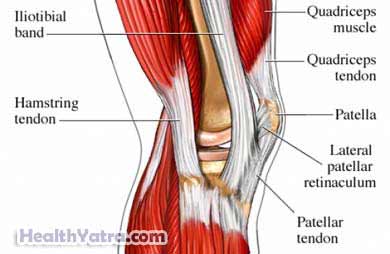تعريف
Iliotibial band syndrome (ITBS) is an overuse injury. It happens in the soft tissues in the lower thigh, near the outside of the knee. The iliotibial band (ITB) is a thick band of fibrous tissue. It runs from the hip down the outside of the thigh and attaches to the tibia. The tibia is the large bone of the lower leg.
العلاج يعتمد على شدة الإصابة.

أسباب
ITBS is caused by repetitive friction or rubbing of the iliotibial band against the bone on the outer side of the knee. This excessive rubbing can irritate the ITB itself and/or the tissue underneath.
Causes of the excessive friction include:
- Structural abnormalities, such as a short, tight IT band
- Problems related to the foot, ankle, or hip
- Opposing muscle imbalances, such as the quadriceps stronger than hamstrings
- A very prominent lateral femoral epicondyle, the bony structure on the outer side of the knee
- Inward rotation of the leg
- Angle where knee flexes
- Legs of different lengths
- Bowlegs
عوامل الخطر
Factors that increase your risk of getting ITBS include:
- Certain sports with repetitive motions, such as running and cycling
- Incorrect training technique
- Increasing distance run or cycling too quickly
- Running up and down hills
- Overtraining
- Using damaged or worn out equipment or footwear
- Wearing improper shoes for a sport or athletic activity
- Athletic equipment that is not properly fit to the user, such as a bicycle
الأعراض
Symptoms of ITBS include:
- Dull aching or burning sensation on the outside of the knee during or after activity
- Sharp stabbing pain on the outside of the knee during or after activity
- Pain that shows up in the hip, known as referred pain
- Progressive, worsening pain
- Snapping, creaking, or popping when the knee is bent and then straightened
التشخيص
Your doctor will ask about your symptoms and medical history. In most cases, diagnosis can be made with a physical exam.
قد تشمل الاختبارات ما يلي:
- Obers test—determines the tightness of the ITB
- Rennes test—specifies the area of pain while full weight is placed on the bent leg
- Nobles test—determines the area of pain while the leg is flexed at a certain angle
For images of the internal structure of your leg, your doctor may recommend an MRI.
العلاج
تحدث مع طبيبك حول أفضل خطة علاجية لك. يتراوح وقت التعافي اعتمادًا على درجة إصابتك. قد تشمل خطوات العلاج ما يلي:
رعاية مركزة
استراحة
Your IT band will need time to heal. Avoid activities that place extra stress on the knee:
- لا تمارس الأنشطة التي تسبب الألم. يتضمن ذلك الجري والقفز ورفع الأثقال باستخدام عضلات الساق.
- إذا كان المشي الطبيعي يؤلمك ، فقم بتقصير خطواتك.
- لا تمارس الرياضة حتى يخبرك طبيبك أنه من الآمن القيام بذلك.
Your doctor may recommend a foot orthotic to help control rototation of the foot. This will help stabilize the knee.
بارد
ضع الثلج أو الكمادات الباردة على المنطقة لمدة 15-20 دقيقة، أربع مرات يوميًا، لعدة أيام بعد الإصابة. لا تضع الثلج مباشرة على بشرتك. لف الثلج أو الكمادات الباردة بمنشفة.
أدوية تخفيف الألم
للتحكم في الألم، قد يوصي طبيبك بما يلي:
- الأدوية المتاحة دون وصفة طبية، مثل الأسبرين أو الإيبوبروفين أو الأسيتامينوفين
- مسكنات الألم الموصوفة طبيًا
- Corticosteroid injections
خطوات الاسترداد
حرارة
استخدم الحرارة فقط عند العودة إلى النشاط البدني. يمكن بعد ذلك استخدام الحرارة قبل التمدد أو الاستعداد لممارسة الرياضة للمساعدة في إرخاء العضلات.
تمتد
عندما يختفي الألم الحاد، ابدأ بتمارين التمدد اللطيفة كما هو موصى به. البقاء ضمن حدود الألم. استمر في كل تمرين لمدة 10 ثوانٍ تقريبًا وكرر ذلك ست مرات. تمتد عدة مرات في اليوم.
تقوية
ابدأ بتمارين تقوية عضلاتك على النحو الموصى به.
جراحة
Surgery may be necessary in cases when there is no response to other forms of treatment.
الوقاية
To reduce your chances of ITBS, take these steps:
- Learning proper training techniques
- Increasing mileage run gradually
- Wearing appropriate shoes for each sport
- Replacing athletic shoes as they show signs of wear
- Being aware of running surfaces
- Using properly fitted equipment
- Strengthening quadriceps, hamstrings, and gluteal muscles
